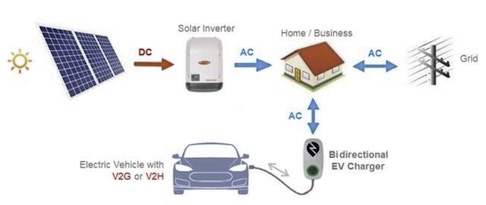
Company officials say its new two-way charger, or bidirectional electrical vehicle chargers, is “expected to work with most electric vehicles.” It successfully demonstrated the system earlier this month and expects to introduce it next year.
With this news, Enphase has joined a short list of manufacturers vying for a share of this vehicle-to-grid (V2G) market that is forecast to reach $28.12 billion by 2026, according to IndustryARC.com.
Bidirectional charging not only allows direct current to alternating current transfers from solar panels to batteries using inverters, it can also reverse the process using AC-to-DC converters to send power from EV batteries back to a residence to keep lights and appliances running in emergencies, as well as return excess power to the grid for credits or refunds.
“The market for ‘green charging’ options is growing, and Enphase’s bidirectional concept has been well received,” said Mohammad Alkuran, Ph.D., senior director of systems engineering at Enphase. “More new electric vehicles are being designed to include two-way charging systems.”
IndustryARC analysts predict the global V2G market to grow at a compound annual growth rate of 4.28% from 2021 to 2026, based on data showing that adoption of electric vehicles worldwide is affecting demand for EV charging infrastructures.
According to Sam Fiorani, vice president of Auto Forecast Solutions, while “bidirectional charging is still in its infancy, once it becomes mainstream it could revolutionize how EV owners view their vehicles. Instead of seeing their cars and pickups as separate from their homes, they could become more integrated into owner’s lives the way the telephone has become over the past decades.”
He said this technology is also seen as an integral part of the next wave of EV evolution — called V2X, the vehicle-to-everything world — that would interconnect transportation and power systems to transfer electricity stored in EV batteries to the grid, buildings, homes and other energy sourcing destinations.
Bidirectional electric-vehicle charging is part of a home energy system that can pull in power from the grid or from on-site sources such as solar panels to charge the vehicle. Properly equipped EVs and chargers can both receive power to charge the battery and send power from the battery to supply the home (vehicle to home, V2H) or the grid (vehicle to grid, V2G).
Bidirectional electric-vehicle charging is part of a home energy system that can pull in power from the grid or from on-site sources such as solar panels to charge the vehicle. Properly equipped EVs and chargers can both receive power to charge the battery and send power from the battery to supply the home (vehicle to home, V2H) or the grid (vehicle to grid, V2G). (courtesy of Clean Energy Reviews)
A handful of manufacturers are already producing two-way power conversion devices, such as Autel Maxi Charger V2X, Brek Electronics, Delta V2X, Emporia Energy, Fermata Energy FE-16, Rectifyer Technologies Highbury and WallBox North America.
These advanced chargers are more sophisticated and expensive than regular chargers since they incorporate state-of-the-art power conversion electronics to manage energy flow to and from the vehicle.
“We’re seeing increased demand for backup emergency power among homeowners who have faced outages due to storms, grid overloads and power failures,” Alkuran said. “These events have prompted many to seek better ways to ensure uninterrupted service enabling them to become more energy self-sufficient. We assist customers in achieving this goal by connecting onsite renewable energy from solar power during the day to be used at night, the next day at home or when driving an EV.”
THE NEW LANGUAGE OF V2G
V2H: Vehicle to home. The EV battery provides backup power for the home.
V2G: Vehicle to grid. Excess power goes from the EV battery to supply the electrical grid.
V2X: Vehicle to everything. EV battery power is interconnected with transportation and building systems.
V2L: Vehicle to load. The vehicle battery powers home appliances and lights as well as external equipment such as compressors or camping equipment.
Electric vehicle market growth
• According to the U.S. Department of Energy, sales of EVs almost doubled between 2020 to 2021 from 308,000 to 600,000 vehicles, and more than 56,000 were sold by March 2022 alone.
• Cumulatively EV manufacturers have sold over 2,531,206 battery and plug-in vehicles in the last 12 years (EarthWeb.com).
• There was a record 60% increase in EV registrations in the first quarter of 2022 (about 158,600) which is 4.6% of all new car registrations in the country.
• In 2022, companies manufactured approximately 441,000 EVs. Using data from most auto brands and EV models, vehicle sales from the industry grew from 2.2% of total sales to 6.1% by the end of 2022.
• Demand for EV chargers is projected to register an impressive compound annual growth rate of 26.6%, according to Future Market Insights (FMI), a leading provider of custom ad syndicated market intelligence, research reports and consulting services.
• FMI also reported that the global EV charger market is anticipated to grow from U.S.$ 5,130.5 million in 2022, to U.S.$ 6,520.9 million in 2023, to about U.S.$ 68,967.2 million by 2033.
